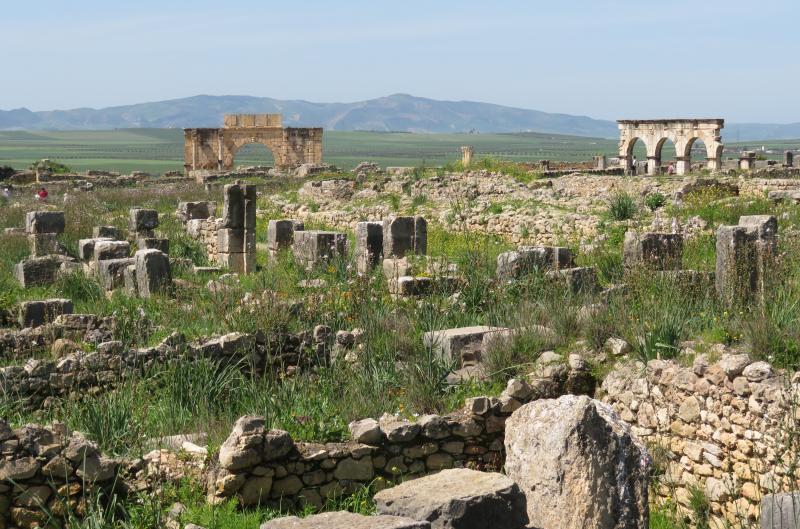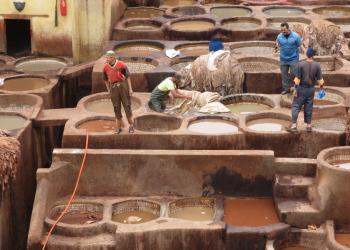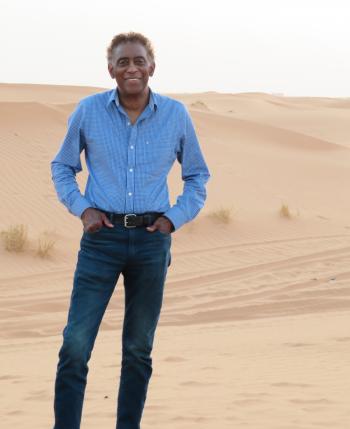Mountains, medinas and more on a journey through Morocco
This article appears on page 18 of the February 2019 issue.
I had just returned home from a long and adventure-filled trip to Ethiopia and Southern Africa in November 2017 when I received a phone call from a travel agent friend asking if I would be interested in a trip to Morocco. I had traveled to more than a dozen countries in sub-Saharan Africa over the previous three years, and, as luck would have it, I had vowed that my next African trip would be to Morocco, so I decided to keep the promise I had made to myself, even if it was a little sooner than I had planned.
Getting started
My March-April 2018 Moroccan travel plans were wide-ranging. I would travel from Casablanca, on the Atlantic Ocean, to the ancient Roman city of Volubilis, on Morocco's fertile plains, continuing across the snowcapped Atlas Mountains to camp in the Sahara desert, then hike the Todra Gorge Oasis before exploring (and enjoying) the souks, kasbahs and medinas of Fes, Marrakech and other cities and towns between my major destinations.
This 2-week tour was with a company I have utilized on several occasions, Global Exploration for Educators Organization (Norristown, PA; 877/600-0105, geeo.org), a nonprofit company offering overseas trips for classroom educators and administrators (current or retired).
The total land-only cost of my trip was $2,054, including hotel accommodations and one, sometimes two, meals a day, as well as the services of a guide and a driver, both of whom were excellent!
After traveling some 15 hours from Los Angeles to Morocco, I finally landed at Mohammed V International Airport in Casablanca around 5:15 p.m. I was in Morocco! And I was determined it was going to be another fun-filled adventure.
I quickly exited the plane, made my way through Customs and Immigration, retrieved my baggage and converted my American dollars into Moroccan dirhams. I then walked briskly toward the exit, where a taxi driver was holding a sign with my name on it.
After exchanging pleasantries with the driver, we drove from the airport toward our destination, Casablanca. During our drive to the city, I was struck by the well-maintained highway we were traveling on and the scenery; much of the scenery reminded me of my native Southern California.
We arrived in downtown Casablanca during heavy rush-hour traffic. Car horns honked while impatient drivers sought to maneuver their cars through the jam-packed roadway.
After arriving at the Kenzi Basma Hotel, where I would be staying for the next several days, I thanked and tipped the driver, grabbed my bags and made my way inside. By the time I entered my room, I was both tired and excited.
However, as is customary for me, I immediately inspected the room for safety and security issues. I quickly noticed that the lock on the window did not lock, and the room smelled like a "smoking" room. (I had specifically requested a nonsmoking room.)
I contacted the front desk to express my concerns. A hotel employee arrived a few minutes later to check the window, but he was unable to lock it. I again called the front desk, this time insisting on another room. (The next morning, I was assigned a large, spacious room with a balcony.)
Feeling somewhat bedraggled, I took a quick shower and rested for a bit before going out for a short exploratory walk.
The Kenzi Basma Hotel is located in a very strategic part of Casablanca, approximately a 5- to 7-minute walk from the tramway station Place des Nations Unies and about 1½ miles from the world-famous Hassan II Mosque.
There were many restaurants and small eateries close to the hotel, and directly adjacent to the rail station was a small park. The hotel also had a bar with entertainment in the evening. One evening, there was a band from Argentina performing.
One of the major drawbacks of the hotel was that it was not smoke-free. Rooms averaged around $85 per night.
Casablanca
On my first full day in Casablanca, I set out to explore other parts of the city on foot. As I casually meandered through the park, it became very obvious that Casablanca was a very diverse and cosmopolitan city. I observed people from practically every corner of the globe.
On the second day, I took a taxi to the Hassan II Mosque. When I arrived, it was teeming with people. I was struck by its immense size and beautiful architectural style. Adding to its allure was its location, along the Atlantic Ocean.
Following my visit to the mosque, I decided to continue my exploratory trek through the city. As I was standing on a street corner taking photos, I was approached by a man. He asked if I was an American, and I said, "Yes." The man introduced himself as Ahmed and shared that he had a friend who lived in Santa Barbara, California. Taken aback, I told him that I was from Santa Barbara. He smiled broadly, grasped my hands and said, "Welcome. Welcome, brother, to Morocco."
Ahmed said he was a Berber, and he proudly recited various aspects of the history and culture of the Berber people.
He asked me if I would be interested in seeing some Berber arts and crafts. I said, "Yes," and off we went to a shop specializing in Berber carvings, art, rugs and linen that turned out to be located less than 10 minutes from my hotel.
Ahmed introduced me to the store owner and asked him to take a photo of the two of us. After the photo was taken, Ahmed shook my hand, embraced me and said good-bye.
I was very impressed with the wide assortment of items in the store, and the store manager was a natural-born salesman — one of the most persistent salesmen I have ever met!
On to Fes
Early the next morning I left Casablanca, making the 4-plus-hour drive to Volubilis, a former ancient Roman outpost. Volubilis' ruins are perhaps the best preserved in Northern Africa, and they are listed as a UNESCO World Heritage Site.
I found the site to be impressive, and I could clearly imagine the lifestyle of the ancient Roman patricians through the art and architecture there. In a series of mosaic floors found inside some of the homes, I was able to catch glimpses of the humor and risqué nature of some of the former homeowners.
From Volubilis, we set out on a 2-hour drive through fertile agricultural land to Fes, an inland city in northern Morocco. Located northeast of the Atlas Mountains, its strategic position has led to its being described as the "crossroad" for the region.
A local guide steered me through the winding maze of Fes' medina, with buildings dating back to the 9th and 10th centuries. The medina contains quarters for artisans, bakers, butchers, carpenters and clothing producers.
One of my personal highlights was seeing the tannery. Standing atop a balcony, I could clearly see men treating and dyeing various types of hides. It was an unforgettable image! (The smell was unforgettable too.)
I found Fes to be a charming and attractive city. I especially enjoyed taking evening strolls, passing the many outdoor cafés and restaurants.
My accommodations in Fes, at The Royal Mirage Fes Hotel, were great. The hotel was top-notch, with a swimming pool, a bar, two restaurants, a gift shop and immaculately cultivated grounds. (The average room price was about $86 per day.)
A night in the desert
After spending a few days in Fes, I was back on the road again. It was a full day's drive of some 11-plus hours as we made our way across the Atlas Mountains to my next destination, Merzouga, on the edge of the Sahara desert.
We arrived a couple of hours before sunset at the jumping-off place for the 1-hour camel ride that would take me to a Berber campground. I wanted to be at the campsite in time to watch the desert sun set.
After gathering the items I needed for my scheduled campout, I mounted a camel for my next great adventure.
The camel ride, for me, was quite easy, bringing back memories of earlier camel rides. I had ridden camels in Egypt many times, though I had not ridden one for more than an hour at one stretch!
After reaching the campsite, I was assigned a tent. Unlike the tents I had grown accustomed to (but quickly came to detest) during my 2017 Southern Africa trip, these tents were not your usual tents; they were "glamping" tents! Large and spacious inside, each was equipped with many of the creature comforts of a small-sized house. They even had flush toilets.
Following dinner, a campfire was lit, and the evening entertainment started soon after. The entertainment, under a beautiful, clear desert sky, was provided by a group of Berber men — quite enjoyable! All in all, it was a memorable night.
During the night, there were dogs howling, which, at times, was a bit unsettling. Taking no chance, I got out of bed to make certain that the tent entrance was secured. It was.
Not long after the howling ended, the fierce winds from the desert started, the strong wind pounding my tent. I soon fell back asleep in my large, comfortable bed, however.
The next morning, raring to get on with the next phase of my journey, I quickly packed my bag, had breakfast and then mounted my camel for the long ride back.
To the kasbah
From the staging area in Merzouga, we drove along a route referred to as the "route of 1,000 kasbahs," stopping at several towns along the way. One of my favorites was Ouarzazate, headquarters for Atlas Film Studios. (Due to its scenic beauty and picturesque countryside, many international films are shot in Morocco.)
Our next stop was Todra Gorge, about 30 minutes' drive from the town of Tinerhir (aka Tinghir). Located in the eastern part of the rugged High Atlas Mountains and tucked neatly between formidable limestone cliffs and a wadi (ravine), Todra Gorge is one of the most beautiful oases I have seen.
I spent the night outside Todra Gorge in the modest Hôtel Bougafer. The hotel did not provide a lot of amenities, but my room did have a balcony that provided me with a good panoramic view of the surrounding town of Tinerhir.
More importantly, the hotel provided a much-needed place to rest before I was on the road again to Aït-Ben-Haddou, the next stop before we reached Marrakech.
The staff at L'Hôtel Bougafer were very friendly and helpful, and the restaurant food was tasty. I especially enjoyed the orange juice. Oranges are one of Morocco's major exports, and fresh orange juice can be found in virtually all Moroccan hotels.
After breakfast, we headed for Aït-Ben-Haddou, located about 150 miles from Merzouga. After a 4-hour journey, we finally arrived.
The community of Aït-Ben-Haddou is known for its large, earthen ksar (fortress), another UNESCO Site. (It is also the site where the movie "Gladiator" was filmed.)
To get to the ksar, I first had to cross a small but nearly dry river. From there on, it was just a matter of avoiding the various shopkeepers and vendors who tried to get me to buy their wares.
I was allowed to go inside one of the kasbahs within the fortress walls, where one family still lived. Most of the other residents had left to live in the surrounding countryside.
I had a chance to speak with an older woman, who proudly showed off her modern refrigerator and the small stove in the family's kitchen.
Next I hiked the steep trail leading up to the top of the fortress, From there, the view was simply stunning!
Marrakech
The drive the next day from Aït-Ben-Haddou to Marrakech, crossing the High Atlas Mountains via the Tizi n'Tichka Pass (some 7,414 feet, or 2,260 meters, in elevation), took some four hours. As we approached the city, the driver, Larry, and the guide, Mohammed, started singing a song they had promised they would sing specifically for me once we reached the outskirts of Marrakech. I was touched and broke out in a broad smile.
The two men had not only taken me across Morocco, but we had forged a deep bond of friendship, and I will forever be grateful to them.
Once we reached the city center, I knew my great Moroccan odyssey was drawing to a close, and I was deeply saddened.
The Moroccan people I encountered had been kind, generous, hospitable and respectful toward me, and the Moroccan landscape had, in so many ways, reminded me often of my home.
In Marrakech, our first stop was Djemaa el Fna square, the very center of the city. It has been called the "busiest square in Africa."
We arrived around 1:30 p.m., and my attention was immediately drawn to the great diversity of people mingling together.
The square pulsated with boundless energy! There were individuals trying to sell items of all kinds to passersby, entertainers performing their acts, and business owners trying to entice customers inside. The place simply buzzed with life, energy and action.
I grabbed a quick snack at one of the local restaurants, and by the time I had finished eating, it was time to meet up with a local guide who would take me on a tour of the medina.
He took me to the Koutoubia Mosque, the sprawling and impressive Bahia Palace, the Saadian Tombs, Ben Youssef Medersa, the Almoravid Koubba and the former Jewish quarter.
After the tour was over, I was driven to the Dellarosa Hotel Suites & Spa, where I would spend the remainder of my Moroccan trip. The Dellarosa was an elegant hotel, located not very far from the square and some of the city's beautiful garden parks.
For all of its elegance and prime location, the hotel was reasonably priced; my room, with a garden patio, cost $115 per night.
I decided to lie down on the bed for some much-needed rest, and I was again struck by the fact that being in Marrakech meant the culmination of my Moroccan trip, though I would spend a few more days in the city before flying to Paris, heading back to Djemaa el Fna square to hear the storytellers and see the snake charmers, the magicians and the various peddlers and shopkeepers.
My journey through Morocco had been highly satisfying and rewarding. Without doubt, it was one of the three best trips I have ever taken. Over the course of the trip, I came to have a deep and abiding affection for Morocco and its people.
My mind reflected on the call I'd received from my friend asking if I'd be interested in visiting Morocco, a call that set the wheels in motion for my memorable Moroccan adventure!




